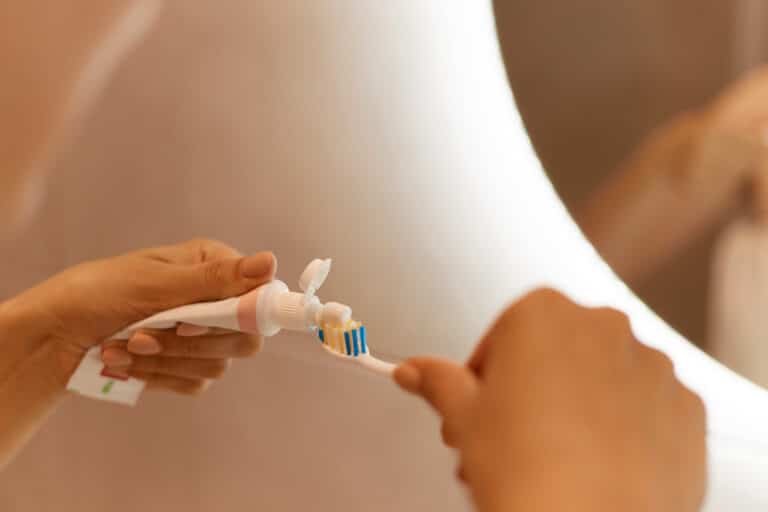When experiencing gum pain or swelling, it can be concerning to think you might have an impacted tooth. Whether it’s wisdom teeth or another tooth, understanding the signs and treatment options is crucial. At WeSmile Dental Care, our qualified and experienced dentists are here to help you through every step of the process. This article will guide you on what an impacted tooth is, how to identify it, and when extraction might be necessary.
What does an impacted tooth look like?

An impacted tooth often doesn’t fully emerge through the gum line. Instead, it might be partially visible or completely hidden. Visually, you might notice:
- A tooth partially erupting through the gum.
- Swollen or red gums around the area.
- A gap where the tooth should have fully emerged.
What does an impacted tooth feel like?
The feeling of an impacted tooth can vary, but common sensations include:
- Discomfort or pain at the back of the mouth.
- Swollen, tender, or bleeding gums.
- Jaw pain or stiffness.
- Bad breath or an unpleasant taste in your mouth.
Is an impacted tooth painful?
Yes, an impacted tooth can be quite painful. The pain often arises from the pressure and movement of the tooth as it tries to emerge but fails to do so completely. This can lead to a variety of uncomfortable symptoms, such as:
- Throbbing Pain: The constant pressure of the tooth against the surrounding tissues can cause a persistent, throbbing pain that is hard to ignore.
- Radiating Pain: The discomfort from an impacted tooth can spread beyond the immediate area, often radiating to the ear, jaw, and even down the neck. This widespread pain can make it challenging to pinpoint the exact source of the problem.
- Chewing Difficulties: Eating can become a painful task. The act of chewing puts additional pressure on the affected area, exacerbating the discomfort and making it difficult to enjoy meals.
- Speech Problems: Speaking may also become uncomfortable as the movement of the jaw and tongue can irritate the impacted area.
- Gum Swelling and Tenderness: The gums around an impacted tooth often become swollen and tender. This can lead to bleeding and increased sensitivity, making oral hygiene practices like brushing and flossing more painful.
- Headaches: The pain from an impacted tooth can sometimes trigger headaches, particularly if the discomfort radiates to the jaw and temples.
- Infections: Impacted teeth can create pockets where bacteria thrive, leading to infections. These infections can cause additional pain, swelling, and sometimes even fever.
Given these potential symptoms, it’s important to seek dental advice if you suspect an impacted tooth. Early diagnosis and treatment can prevent the pain from worsening and avoid complications.
Can wisdom teeth be impacted?
Wisdom teeth, also known as third molars, are the most common teeth to become impacted. This often occurs because there isn’t enough space in the mouth for them to emerge properly, causing wisdom teeth to push against neighbouring teeth or grow at an awkward angle. This leads to partial or complete impaction.
Types of wisdom teeth impaction:

- Partial Impaction: This occurs when the wisdom tooth partially emerges through the gum line. Partially impacted wisdom teeth can create openings where bacteria can enter, leading to infections and gum disease.

- Complete Impaction: This happens when the wisdom tooth fails to break through the gum line and remains entirely within the jawbone. Complete impactions can cause significant discomfort and complications, such as cysts or damage to adjacent teeth.
Angles of wisdom teeth impaction:
Mesial Impaction
Mesial Impaction is when the wisdom tooth is angled forward towards the front of the mouth, pressing against the adjacent second molar.
Complications: This can cause pain, tooth misalignment, and difficulty cleaning between teeth, increasing the risk of cavities and gum disease. The pressure on adjacent teeth can also lead to swelling and inflammation.
Vertical Impaction
Vertical Impaction is when the wisdom tooth is positioned correctly but fails to erupt fully due to lack of space.
Complications: This can lead to partial eruption, creating pockets for bacteria to accumulate, resulting in infections, abscesses, and cyst formation, potentially damaging surrounding bone and tissues.
Horizontal Impaction
Horizontal Impaction is when the wisdom tooth lies horizontally within the jaw, pushing into the roots of the adjacent second molar.
Complications: This type can cause severe pressure on adjacent teeth, leading to root damage, misalignment, and significant pain and swelling. The orientation often results in damage that may require additional dental procedures.
Distal Impaction
Distal Impaction is when the wisdom tooth is angled towards the back of the mouth, away from other teeth.
Complications: This positioning can complicate extraction and increase the risk of gum infections and periodontal disease due to hard-to-reach areas, leading to jaw pain and difficulty maintaining oral hygiene.
All types of impaction can lead to cysts, tumors, chronic pain, and infections, which can spread and cause more serious health issues. Regular dental check-ups and early intervention are essential for preventing these complications.
How do I know I have a partially impacted wisdom tooth?
A partially impacted wisdom tooth might show these signs:
- A tooth partially breaking through the gum: You may see a portion of the tooth emerging through the gum line, but it doesn’t fully erupt into the mouth.
- Red, swollen, or tender gums around the area: The gum tissue around the partially emerged tooth may appear red and swollen, and feel tender to the touch, indicating inflammation or infection.
- Pain or discomfort at the back of the mouth: You might experience consistent pain or discomfort localized at the back of your mouth, which can worsen when chewing or applying pressure to the area.
- Difficulty opening your mouth fully: Swelling and pain from the impacted tooth can limit your ability to open your mouth wide, making activities like eating and speaking uncomfortable.
Do I need to have an extraction for an impacted tooth?
In many cases, an impacted tooth requires extraction to prevent further complications, such as infection, cysts, or damage to adjacent teeth. A consultation with our experienced dentists at WeSmile Dental Care will determine the best course of action.
Does an impacted tooth require oral surgery?
 Yes, impacted teeth often require oral surgery for extraction. This procedure is typically straightforward and performed under local anaesthesia.
Yes, impacted teeth often require oral surgery for extraction. This procedure is typically straightforward and performed under local anaesthesia.
Surgical extraction of impacted wisdom teeth is a routine procedure performed by dentists and oral surgeons worldwide. Advances in dental technology and techniques have made these surgeries safer and more efficient than ever before.
At WeSmile Dental Care, our skilled dentists are highly trained in performing wisdom tooth extractions. They follow strict protocols to minimise risks and ensure a smooth and safe experience for all patients. We prioritise being minimally invasive, reducing the amount of tissue damage and speeding up recovery time. This means less postoperative pain and a lower risk of complications such as infection or dry socket.
While all surgeries carry some risk, wisdom tooth extractions are generally low-risk procedures. Complications are rare, especially when the surgery is performed by experienced professionals.
Our team provides detailed preoperative and postoperative care instructions to help patients prepare for the surgery and recover quickly. Follow-up appointments ensure that any concerns are addressed promptly and that healing is progressing well.
Is gum erupted tooth extraction necessary?
If a tooth has partially erupted through the gum but is causing pain, infection, or other dental issues, extraction might be necessary. This helps prevent further complications and promotes better oral health. It is essential to seek advice from a dentist if you have a partially erupted tooth. A professional evaluation can determine whether extraction is the best course of action for your specific situation.
What is the process of extracting an impacted tooth?
The process of extracting an impacted tooth typically involves several steps to ensure a safe and effective procedure:
Consultation & examination – Before extraction, we conduct a detailed and focused consultation that includes a thorough examination and X-rays to determine if extraction is the best course of action. This comprehensive evaluation allows our dentists to understand the exact position and condition of the impacted tooth and plan the most appropriate treatment.
Anaesthesia – Local anaesthesia is administered to numb the area and ensure your comfort throughout the procedure. In some cases, sedation may be offered to help you relax further during the extraction.
Extraction – Depending on the tooth’s position, the dentist will make an incision in the gum to access the impacted tooth. If necessary, any bone blocking the tooth will be carefully removed. The tooth is then extracted using specialised instruments. For complex cases, the tooth may be sectioned into smaller pieces to facilitate removal.
Stitches – After the tooth is removed, the gum may be stitched to promote healing. These stitches are usually dissolvable and will disappear on their own over time.
Recovery – Our team will provide detailed post-operative care instructions to manage pain and promote healing. This includes guidance on pain relief, swelling reduction, diet, and oral hygiene practices. Follow-up appointments may be scheduled to monitor your recovery and address any concerns.
Importance of early intervention for an impacted tooth
 As we’ve covered, impacted teeth can lead to a range of issues, including pain, infections, and damage to surrounding teeth and bone. Ignoring these signs or delaying treatment can worsen these problems, making them harder to manage later on.
As we’ve covered, impacted teeth can lead to a range of issues, including pain, infections, and damage to surrounding teeth and bone. Ignoring these signs or delaying treatment can worsen these problems, making them harder to manage later on.
It’s important to seek early intervention to avoid these complications and maintain good oral health. At WeSmile Dental Care, we’re here to help you through every step, from a thorough consultation to effective treatment.
If you’re feeling pain or discomfort around a tooth, don’t wait. Reach out to us today for a friendly, professional evaluation and let us help you achieve a healthier, more comfortable smile. Your well-being is our top priority.
Additional FAQs
Is the extraction of an impacted tooth painful?
The extraction itself is not painful due to local anaesthesia. However, you might experience some discomfort during the recovery period. Our dentists at WeSmile Dental Care will provide pain management options and aftercare instructions to ensure a smooth recovery.
When should I extract my impacted tooth?
It’s best to extract an impacted tooth as soon as it causes symptoms or if our dentists identify potential complications during a routine check-up. Early extraction can prevent more severe issues and promote quicker healing.
What are the risks of not extracting an impacted tooth?
Not extracting an impacted tooth can lead to several serious complications. One of the most common risks is infection, as the partially erupted tooth can create pockets where bacteria can thrive. This can result in painful abscesses and gum disease.
Additionally, impacted teeth can cause the formation of cysts, which are fluid-filled sacs that can damage surrounding bone and tissues. There is also the risk of damage to adjacent teeth due to the pressure exerted by the impacted tooth. Over time, this can lead to more severe pain and discomfort, making it even more crucial to address the issue promptly.
How long is the recovery time after an extraction?
Recovery from a tooth extraction typically takes about a week. Most patients find that they can resume their normal activities within a few days. During this time, it’s important to follow post-operative care instructions to ensure a smooth healing process. You might experience some swelling and discomfort initially, but these symptoms usually subside quickly.
Can all impacted teeth be removed in a single visit?
In many cases, it is possible to remove all impacted teeth in a single visit, especially if they are in similar conditions. However, each situation is unique, and our dentists will assess your specific case to determine the best approach.
Factors such as the position of the teeth, their level of impaction, and your overall dental health will influence the treatment plan. We’ll work with you to ensure the procedure is tailored to your needs, aiming for the best outcome with minimal discomfort.


